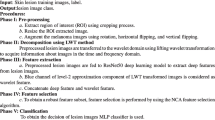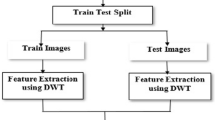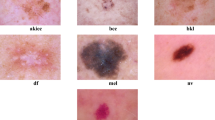Abstract
An automated system for skin cancer diagnosis is needed for early diagnosis to reduce the mortality rate of skin cancer. Noninvasive clinical routines are essential for diagnosis, but they are largely subjective. In this study, a hybrid deep learning (HDL) approach that uses subband fusion of 3D wavelets is proposed. It is a noninvasive and objective method for inspecting skin images. In the first stage of the HDL approach, simple median filtering is used to remove unwanted information such as hair and noise. In the second stage, the 3D wavelet transform is applied to obtain textural information from the dermoscopic image via a subband fusion approach. In the final stage, multiclass classification is performed by the HDL approach using the fused subband. The performance results of the HDL approach on PH2 database images indicate that it can discriminate normal, benign, and malignant skin images effectively with 99.33% average accuracy and more than 90% sensitivity and specificity. This study confirms the observation that the HDL approach can realize improved classification results.










Similar content being viewed by others
References
Ganster H, Pinz P, Rohrer R, Wildling E, Binder M et al (2001) Automated melanoma recognition. IEEE Trans Med Imaging 20(3):233–239
Barata C, Ruela M, Francisco M, Mendonça T, Marques JS (2013) Two systems for the detection of melanomas in dermoscopy images using texture and color features. IEEE Syst J 8(3):965–979
Nasir M, Attique Khan M, Sharif M, Lali IU, Saba T et al (2018) An improved strategy for skin lesion detection and classification using uniform segmentation and feature selection based approach. Microsc Res Techn 81(6):528–543
Abuzaghleh O, Barkana BD, Faezipour M (2015) Non invasive real-time automated skin lesion analysis system for melanoma early detection and prevention. IEEE J Transl Eng Health Med 3:1–12
Xie F, Li H, Fan Y, Jiang Z, Meng R et al (2016) Melanoma classification on dermoscopy images using a neural network ensemble model. IEEE Trans Med Imaging 36(3):849–858
Sonia R (2016) Melanoma image classification system by NSCT features and Bayes classification. Int J Adv Signal Image Sci 2(2):27–33
González-Díaz I (2017) Incorporating the knowledge of dermatologists to convolutional neural networks for the diagnosis of skin lesions. In: Arvix: computer vision and pattern recognition, pp 1–5
Murugan S, Anjali B, Ganeshbabu TR (2015) Object recognition based on empirical wavelet transforms. Int J MC Square Sci Res 7(1):74–80
Mahbod A, Schaefer G, Wang C, Ecker R, Ellinge I (2019) Skin lesion classification using hybrid deep neural networks. In: IEEE International Conference On Acoustics, Speech and Signal Processing, Brighton, UK, pp 1229–1233
Lakshmi VV, Jasmine JS (2021) A hybrid artificial intelligence model for skin cancer diagnosis. Comput Syst Sci Eng 37(2):233–245
Jacob S, Rosita JD (2021) Fractal model for skin cancer diagnosis using probabilistic classifiers. Int J Adv Signal Image Sci 7(1):21–29
Ghali F (2019) Skin cancer diagnosis by using fuzzy logic and GLCM. J Phys Conf Ser 1279(1):1–10
Thamizhamuthu R, Manjula D (2021) Skin melanoma classification system using deep learning. Comput Mater Contin 68(1):1147–1160
Khan MA, Zhang YD, Sharif M, Akram T (2021) Pixels to classes: intelligent learning framework for multiclass skin lesion localization and classification. Comput Electr Eng 90:1–14
Khan MA, Sharif M, Akram T, Bukhari SAC, Nayak RS (2020) Developed Newton-Raphson based deep features selection framework for skin lesion recognition. Pattern Recogn Lett 129:293–303
Saeed J, Zeebaree S (2021) Skin lesion classification based on deep convolutional neural networks architectures. J Appl Sci Technol Trends 2(1):41–51
Iqbal I, Younus M, Walayat K, Kakar MU, Ma J (2021) Automated multi-class classification of skin lesions through deep convolutional neural network with dermoscopic images. Comput Med Imaging Graph 88:1–10
Rodrigues DDA, Ivo RF, Satapathy SC, Wang S, Hemanth J et al (2020) A new approach for classification skin lesion based on transfer learning, deep learning, and IoT system. Pattern Recogn Lett 136:8–15
Manne R, Kantheti S, Kantheti S (2020) Classification of skin cancer using deep learning, convolutional neural networks—opportunities and vulnerabilities—a systematic review. Int J Modern Trends Sci Technol 6(11):101–108
Chaturvedi SS, Gupta K, Prasad PS (2020) Skin lesion analyser: an efficient seven-way multi-class skin cancer classification using MobileNet. In: International Conference on Advanced Machine Learning Technologies and Applications, pp 165–176
Al-Masni MA, Kim DH, Kim TS (2020) Multiple skin lesions diagnostics via integrated deep convolutional networks for segmentation and classification. Comput Methods Programs Biomed 190:1–12
Gong A, Yao X, Lin W (2020) Dermoscopy image classification based on StyleGANs and decision fusion. IEEE Access 8:70640–70650
Divakara SS, Patilkulkarni S, Raj CP (2020) Novel DWT/IDWT architecture for 3D with nine stage 2D parallel processing using split distributed arithmetic. Int J Image Graph 20(3):1–19
Simonyan K, Zisserman A (2015) Very deep convolutional networks for large-scale image recognition. In: 3rd International Conference on Learning Representations, San Diego, CA, USA, pp 1–14
Mendonça T, Ferreira PM, Marques JS, Marcal AR, Rozeira J (2013) PH2-A dermoscopic image database for research and benchmarking. In: 35th Annual International Conference on Engineering in Medicine and Biology society, Osaka, Japan, pp 5437–5440
PH2 Database. https://www.fc.up.pt/addi/ph2%20database.html
Author information
Authors and Affiliations
Corresponding author
Additional information
Publisher's Note
Springer Nature remains neutral with regard to jurisdictional claims in published maps and institutional affiliations.
Rights and permissions
About this article
Cite this article
Maniraj, S.P., Maran, P.S. A hybrid deep learning approach for skin cancer diagnosis using subband fusion of 3D wavelets. J Supercomput 78, 12394–12409 (2022). https://doi.org/10.1007/s11227-022-04371-0
Accepted:
Published:
Issue Date:
DOI: https://doi.org/10.1007/s11227-022-04371-0




